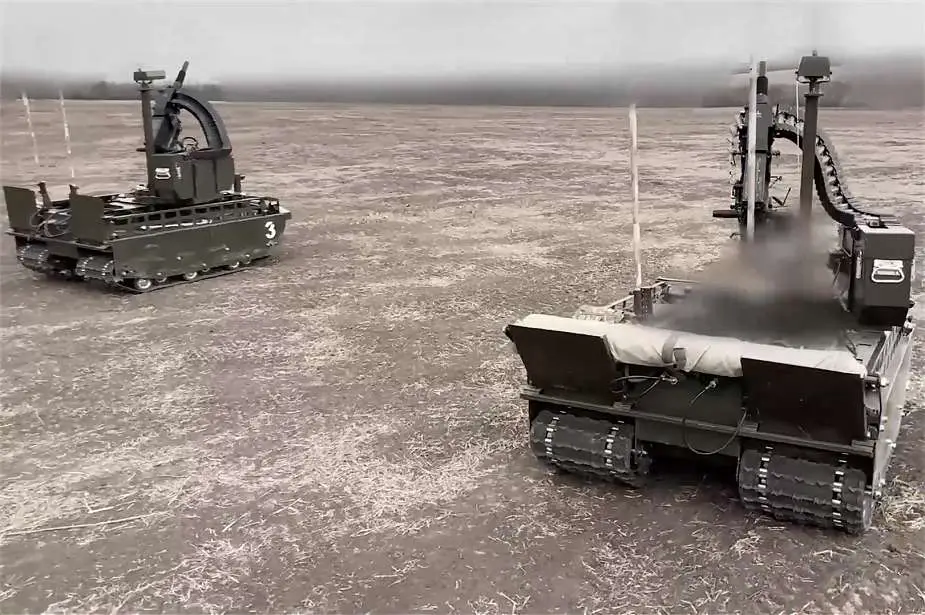In this article, we delve into the combat capabilities and operational details of the 'Courier' drone, which was recently featured in the first combat drone engagement involving both Russian and Ukrainian unmanned systems on March 30, 2024. The Courier, a Russian unmanned ground vehicle (UGV), can be equipped with several types of armaments, including an AGS-17 or AGS-30 automatic grenade launcher, and a mine-laying system for TM-62 and TM-83 anti-tank mines.
Follow Army Recognition on Google News at this link

The Russian-made Courier UGV Unammed Ground Vehicle is now deployed in Ukraine. (Picture source Russian Social Network)
This Courier UGV (Unmanned Ground Vehicle) represents a significant advancement in unmanned military technology, combining mobility with heavy armament to perform complex battlefield tasks. We'll explore its design, strategic utility, and the implications of such technologies in modern warfare, providing a comprehensive overview of its role in the reported encounter
The Courier is engineered to undertake a broad spectrum of military tasks, enhancing both strategic flexibility and battlefield effectiveness. This robotic system is primarily designed for fire support and mine-laying operations, enabling it to support ground troops by providing heavy firepower and creating defensive or disruptive minefields against enemy forces. With these capabilities, the Courier serves as a multifunctional platform capable of adapting to the complex demands of modern warfare.
In terms of specifications, the Courier is not just robust but also compact, with dimensions of 1,400 mm by 1,200 mm by 580 mm, making it ideally suited for operations in varied terrains. It weighs approximately 250 kilograms and is capable of reaching speeds up to 35 km/h. The propulsion system of the Courier relies on a crawler mechanism powered by 6 kW electric motors, enhancing its agility and stability on challenging surfaces.
Armament is a significant aspect of the Courier, equipped with AGS-17 and AGS-30 automatic grenade launchers, each capable of holding up to 150 grenades, providing substantial firepower. Furthermore, it includes an NSVT 12.7 machine gun with a belt capacity of 250 rounds and a PKT 7.62 machine gun that can carry up to 900 rounds, ensuring sustained fire support during prolonged engagements. For anti-tank capabilities or demolition tasks, the Courier can deploy RPO, RPG-7, RPG-26, and RPG-30 grenades, with a total capacity to carry four such weapons.
One of the defining features of the Courier is its ability to lay mines, using Soviet-made anti-tank TM-62 and TM-83 mine layers, capable of deploying up to 8 mines in minutes, thus enabling it to fortify positions or prevent enemy movement effectively. The vehicle’s operational endurance ranges from 12 to 72 hours, and it can be controlled remotely within a range of 3 to 10 kilometers, depending on the operational environment and the need for stealth or direct control.
Additionally, the Courier is equipped with a 560-watt radio-electronic combat (REB) system, enhancing its capability to disrupt enemy communications and sensor systems, thus providing not only direct combat support but also electronic warfare capabilities. This integration of firepower, mobility, and electronic warfare makes the Courier a formidable tool in modern combat scenarios, reflecting significant advancements in unmanned military technology.
In the Russian-Ukrainian conflict, the use of unmanned ground vehicles (UGVs) like the Russian Courier exemplifies the increasing reliance on robotic systems to enhance combat capabilities and operational flexibility. UGVs bring several advantages, such as reducing the risk to human life, providing sustained firepower, and executing tasks in environments that are hazardous for human soldiers. Systems like the Courier, equipped with diverse armaments and mine-laying capabilities, are particularly valuable for tasks such as area denial, fortification, and support roles in direct engagements.
Defense News April 2024
















